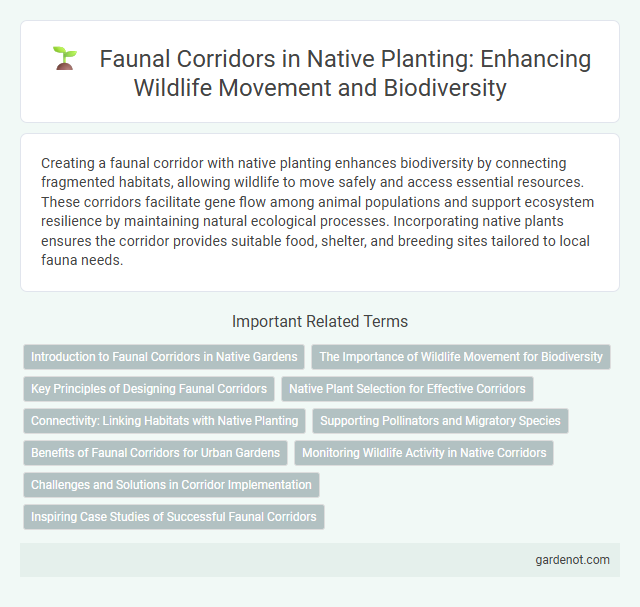Creating a faunal corridor with native planting enhances biodiversity by connecting fragmented habitats, allowing wildlife to move safely and access essential resources. These corridors facilitate gene flow among animal populations and support ecosystem resilience by maintaining natural ecological processes. Incorporating native plants ensures the corridor provides suitable food, shelter, and breeding sites tailored to local fauna needs.
Introduction to Faunal Corridors in Native Gardens
Faunal corridors in native gardens serve as vital pathways that connect fragmented habitats, allowing wildlife such as birds, insects, and small mammals to move safely between green spaces. These corridors enhance biodiversity by maintaining ecological processes and supporting species migration, breeding, and foraging activities. Incorporating native plants in these corridors provides essential food sources and shelter, fostering resilient ecosystems within urban and suburban landscapes.
The Importance of Wildlife Movement for Biodiversity
Faunal corridors enable vital wildlife movement, supporting gene flow and reducing species isolation, which enhances overall biodiversity. These natural pathways connect fragmented habitats, allowing animals to access food, mates, and shelter, thereby maintaining ecosystem resilience. Protecting and restoring native planting within these corridors is essential for sustaining diverse wildlife populations and ecological balance.
Key Principles of Designing Faunal Corridors
Effective faunal corridor design prioritizes habitat connectivity, ensuring native plant species create continuous, diverse habitats that support wildlife movement and genetic exchange. Incorporating structural complexity with layered vegetation promotes shelter, food availability, and safe passage for various fauna. Strategic placement around water sources and minimizing human disturbance further enhance corridor functionality and ecosystem resilience.
Native Plant Selection for Effective Corridors
Selecting native plants with diverse structural layers and seasonal blooms supports effective faunal corridors by providing essential food, shelter, and breeding habitats for local wildlife. Prioritizing species that attract pollinators and sustain native fauna enhances connectivity between fragmented habitats, promoting biodiversity and ecosystem resilience. Incorporating region-specific native flora ensures the corridor aligns with natural ecological processes and wildlife movement patterns.
Connectivity: Linking Habitats with Native Planting
Faunal corridors enhance biodiversity by connecting fragmented habitats through strategic native planting, enabling safe passage and genetic exchange among wildlife populations. Native vegetation provides essential food sources, shelter, and breeding grounds, supporting species resilience and promoting ecosystem health. Effective corridor design prioritizes indigenous plant species to restore natural ecological networks and improve landscape connectivity.
Supporting Pollinators and Migratory Species
Native planting creates faunal corridors that support pollinators such as bees, butterflies, and hummingbirds by providing essential nectar sources and habitat connectivity. These corridors facilitate the movement of migratory species, enabling safe passage and access to critical resources across fragmented landscapes. Enhancing biodiversity through native vegetation improves ecosystem resilience and promotes the survival of both resident and transient wildlife populations.
Benefits of Faunal Corridors for Urban Gardens
Faunal corridors enhance urban gardens by facilitating wildlife movement and increasing biodiversity, which promotes healthier ecosystems. These corridors support pollinators like bees and butterflies, essential for native plant reproduction and yield improvement. Connecting fragmented habitats also helps reduce genetic isolation, ensuring resilient and sustainable urban green spaces.
Monitoring Wildlife Activity in Native Corridors
Monitoring wildlife activity in native faunal corridors provides critical data on species movement patterns, habitat use, and biodiversity levels. Effective tracking techniques such as camera traps, GPS collars, and acoustic sensors offer real-time insights into animal behavior and corridor connectivity. Analyzing this information helps optimize corridor design and management, enhancing native planting efforts to support ecosystem health and species conservation.
Challenges and Solutions in Corridor Implementation
Faunal corridors face challenges such as habitat fragmentation, human-wildlife conflicts, and invasive species disrupting native ecosystems. Effective solutions include restoring native vegetation to enhance habitat connectivity, implementing wildlife-friendly fencing, and engaging local communities in corridor monitoring and maintenance. Integrating GIS mapping and native planting strategies ensures corridors support biodiversity and facilitate safe animal movement.
Inspiring Case Studies of Successful Faunal Corridors
Faunal corridors, designed to connect fragmented habitats, have proven essential in restoring biodiversity and enabling species migration. Successful examples include the Yellowstone to Yukon Corridor in North America, which spans over 3,200 kilometers, facilitating the movement of wildlife such as grizzly bears and wolves. Another inspiring case is the Terai Arc Landscape in Nepal and India, where native planting has restored critical habitats for endangered species like the Bengal tiger and Asian elephant.
Faunal corridor Infographic

 gardenot.com
gardenot.com